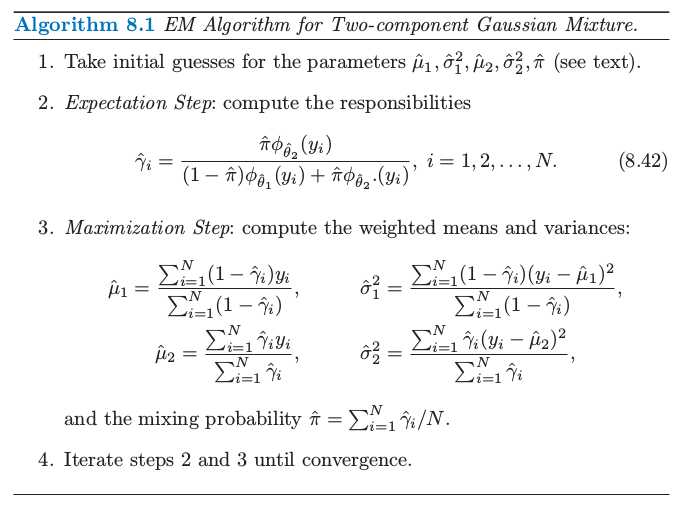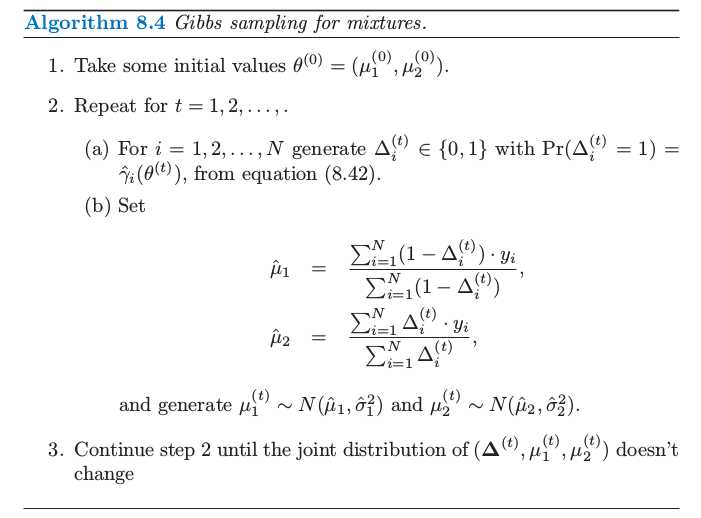对于如下的两类别的高斯混合模型
\[ \pi\cdot N(\mu_1,\sigma_1^2)+(1-\pi)\cdot N(\mu_2,\sigma_2^2) \]
参数为\(\theta = (\pi, \mu_1,\mu_2,\sigma_1,\sigma_2)\)。至今,我了解到有三种方式来估计这五个参数。这三种方式分别为梯度下降法、EM算法和Gibbs采样,而且这三种算法并非毫不相关。EM算法其实是简化梯度下降法中对于对数似然的计算,而Gibbs采样跟EM算法区别在于前者采样后者求最大值。
梯度下降法
思想其实很简单,就是极大似然法,但是解析形式不好确定,好在我们可以通过梯度下降来实现,而且现在有很方便的深度学习框架(如tensorflow)可以实现梯度下降,从而估计参数。下面用一个实际的例子(取自为什么统计学家也应该学学 TensorFlow)来展示梯度下降这一过程
import numpy as np
import matplotlib.pyplot as plt
np.random.seed(123)
# Parameters
p1 = 0.3
p2 = 0.7
mu1 = 0.0
mu2 = 5.0
sigma1 = 1.0
sigma2 = 1.5
# Simulate data
N = 1000
x = np.zeros(N)
ind = np.random.binomial(1, p1, N).astype(‘bool_‘)
n1 = ind.sum()
x[ind] = np.random.normal(mu1, sigma1, n1)
x[np.logical_not(ind)] = np.random.normal(mu2, sigma2, N - n1)
# Histogram
#plt.hist(x, bins=30)
#plt.show()
# #############
import tensorflow as tf
import tensorflow.contrib.distributions as ds
# Define data
t_x = tf.placeholder(tf.float32)
# Define parameters
t_p1_ = tf.Variable(0.0, dtype=tf.float32)
t_p1 = tf.nn.softplus(t_p1_)
t_mu1 = tf.Variable(0.0, dtype=tf.float32)
t_mu2 = tf.Variable(1.0, dtype=tf.float32)
t_sigma1_ = tf.Variable(1.0, dtype=tf.float32)
t_sigma1 = tf.nn.softplus(t_sigma1_)
t_sigma2_ = tf.Variable(1.0, dtype=tf.float32)
t_sigma2 = tf.nn.softplus(t_sigma2_)
# Define model and objective function
t_gm = ds.Mixture(
cat=ds.Categorical(probs=[t_p1, 1.0 - t_p1]),
components=[
ds.Normal(t_mu1, t_sigma1),
ds.Normal(t_mu2, t_sigma2),
]
)
t_ll = tf.reduce_mean(t_gm.log_prob(t_x))
# Optimization
optimizer = tf.train.GradientDescentOptimizer(0.5)
train = optimizer.minimize(-t_ll)
# Run
sess = tf.Session()
init = tf.global_variables_initializer()
sess.run(init)
for _ in range(500):
sess.run(train, {t_x: x})
print(‘Estimated values:‘, sess.run([t_p1, t_mu1, t_mu2, t_sigma1, t_sigma2]))
print(‘True values:‘, [p1, mu1, mu2, sigma1, sigma2])EM算法
这一部分在我的ESL-CN翻译项目的8.5 EM算法一节中有详细介绍。具体算法如下:

R语言代码如下(也可以在ESL-CN项目中找到):
## EM Algorithm for Two-component Gaussian Mixture
##
## author: weiya
## date: 2017-07-19
## construct the data in figure 8.5
y = c(-0.39, 0.12, 0.94, 1.67, 1.76, 2.44, 3.72, 4.28, 4.92, 5.53,
0.06, 0.48, 1.01, 1.68, 1.80, 3.25, 4.12, 4.60, 5.28, 6.22)
## left panel of figure 8.5
hist(y, breaks = 12, freq = FALSE, col = "red", ylim = c(0, 1))
## right panel of figure 8.5
plot(density(y), ylim = c(0, 1), col = "red")
rug(y)
fnorm <- function(x, mu, sigma)
{
return(1/(sqrt(2*pi)*sigma)*exp(-0.5*(x-mu)^2/sigma))
}
IterEM <- function(mu1, mu2, sigma1, sigma2, pi0, eps)
{
cat(‘Start EM...\n‘)
cat(paste0(‘pi = ‘, pi0, ‘\n‘))
iters = 0
ll = c()
while(TRUE)
{
## Expectation step: compute the responsibilities
## calculate the delta‘s expectation
gamma = sapply(y, function(x) pi0*fnorm(x, mu2, sigma2)/((1-pi0)*fnorm(x, mu1, sigma1) + pi0*fnorm(x, mu2, sigma2)))
ll = c(ll, sum((1-gamma)*log(fnorm(y,mu1,sigma1))+gamma*log(fnorm(y, mu2, sigma2))+(1-gamma)*log(1-pi0)+gamma*log(pi0)))
## Maximization Step: compute the weighted means and variances
mu1.new = sum((1-gamma)*y)/sum(1-gamma)
mu2.new = sum(gamma*y)/sum(gamma)
sigma1.new = sqrt(sum((1-gamma)*(y-mu1.new)^2)/sum(1-gamma))
sigma2.new = sqrt(sum((gamma)*(y-mu2.new)^2)/sum(gamma))
pi0.new = sum(gamma)/length(y)
cat(paste0(‘pi = ‘, pi0.new, ‘\n‘))
if (abs(pi0.new-pi)< eps || iters > 50)
{
cat(‘Finish!\n‘)
cat(paste0(‘mu1 = ‘, mu1.new, ‘\n‘,
‘mu2 = ‘, mu2.new, ‘\n‘,
‘sigma1^2 = ‘, sigma1.new^2, ‘\n‘,
‘sigma2^2 = ‘, sigma2.new^2))
break
}
mu1 = mu1.new
mu2 = mu2.new
sigma1 = sigma1.new
sigma2 = sigma2.new
pi0 = pi0.new
iters = iters + 1
}
return(ll)
}
## take initial guesses for the parameters
mu1 = 4.5; sigma1 = 1
mu2 = 1; sigma2 = 1
pi0 = 0.1
eps = 0.01
ll = IterEM(mu1, mu2, sigma1, sigma2, pi0, eps)
## Figure 8.6
plot(1:length(ll), ll, xlab = ‘iterations‘, ylab = ‘Log-likelihood‘, ‘o‘)Gibbs采样
这一部分在我的ESL-CN翻译项目的8.6 MCMC向后采样一节中有详细介绍。具体算法如下:

R语言代码如下(也可以在ESL-CN项目中找到):
## Gibbs sampling for mixtures
## based on the algorithm 8.4 of ESL
##
## Author: weiya
## Date: 2017.09.12
## data in figure 8.5
y = c(-0.39, 0.12, 0.94, 1.67, 1.76, 2.44, 3.72, 4.28, 4.92, 5.53,
0.06, 0.48, 1.01, 1.68, 1.80, 3.25, 4.12, 4.60, 5.28, 6.22)
## initial values
mu1 = 4
mu2 = 1
sigma1 = 0.93
sigma2 = 0.88
N = length(y)
t = 0
mu1.h = mu1
mu2.h = mu2
Delta = rep(c(0, 1), each = N/2)
pi0 = sum(Delta)/N
pi0.h = pi0
while(TRUE)
{
t = t + 1
gamma = sapply(1:N, function(i) pi0*dnorm(y[i], mu2, sigma2)/((1-pi0)*dnorm(y[i], mu1, sigma1)+pi0*dnorm(y[i], mu2, sigma2)))
## sample Delta
r = runif(N)
Delta[gamma < r] = 0
Delta[gamma >= r] = 1
pi0 = sum(Delta)/N
## re-calculate mu1 and mu2
mu1 = sum((1-Delta)*y)/(sum(1-Delta)+1e-10)
mu2 = sum(Delta*y)/(sum(Delta)+1e-10)
## print info
cat("t = ", t, "\n")
for (i in 1:N)
cat(Delta[i], " ")
cat("\n")
cat("mu1 = ", mu1, " mu2 = ", mu2, "pi0 = ",pi0, "\n")
## generate mu1 and mu2
mu1 = rnorm(1, mu1, sigma1)
mu2 = rnorm(1, mu2, sigma2)
mu1.h = c(mu1.h, mu1)
mu2.h = c(mu2.h, mu2)
pi0.h = c(pi0.h, pi0)
if (t > 200)
break
}
## res
## sometimes good, while sometimes bad.
## In addition, sometimes mu1 and mu2 are inverted.